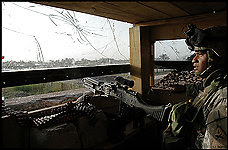Silk Rd Security Outposts
HOPES are high that an ambitious program by Australian combat engineers to construct a chain of forts and bunkers in territory recently won back from Taliban insurgents will create peace in a strategic Afghan valley.
The Australian military, at first regarded with suspicion, now has a friendly partnership with locals in the Chora Valley, said Lieutenant Colonel David Wainwright, commander of the 400-strong Reconstruction Task Force.
Colonel Wainwright told The Weekend Australian the presence of Australian troops had allowed children to return to school in a province where the literacy rate is only 3 per cent.
Commerce in the Chora Valley, 35km northeast of the main Australian base at Tarin Kowt, is thriving and suspicion is giving way to co-operation.
"The first days we started patrolling in Chora the people were quite timid. Within two or three days the Australian soldiers, with their great ambassador skills, had shone through and we were seeing little kids with their thumbs up," Colonel Wainwright said.
 The Silk Road is the most well-known trading route of ancient Chinese civilization. Trade in silk grew under the Han Dynasty ( 202 BC - AD 220) in the first and second centuries AD.
The Silk Road is the most well-known trading route of ancient Chinese civilization. Trade in silk grew under the Han Dynasty ( 202 BC - AD 220) in the first and second centuries AD.
Spanning Two Continents
http://library.thinkquest.org/13406/sr/
http://www.chinapage.com/silkroad.html

The big security test will come next year after the mountain snows melt -- the so-called fighting season between June and November when the Taliban are expected to return from their sanctuaries in Pakistan.
Australian military commanders are hopeful the presence of newly trained and equipped Afghan army units and police occupying the small forts in the valley will be enough to discourage the insurgents.
The Chora Valley mud-brick forts and bunkers, designed to withstand direct hits from rifles and shoulder-launched rockets, are called checkpoints by the Australians who built them.
Once part of the Silk Road, the beautiful valley is known as the green zone because of its almond orchids and crops, including marijuana, watered by an intricate network of ancient hand-dug ditches.
This week, The Weekend Australian was among a small group of journalists given access for the first time to this frontline area.
The gruelling 35km drive north by night in a Bushmaster armoured infantry vehicle took eight hours.
Frequent stops were made to check for roadside bombs before the convoy picked up a dirt track entering the Chora Valley.
It was in this area that Trooper David Pearce's armoured vehicle was ambushed on October 8, killing the father of two.
The RTF arrived here in force near the end of operation Spin Ghar -- a 20-day battle involving British marines and Gurkhas. "Several months ago, you would not have been able to stand here.
As far as the security situation goes, it has markedly improved," said Major Michael Bassingthwaighte, who is in charge of security for the RTF engineers.
"The strategic benefit of occupying this piece of terrain denies the Taliban freedom of movement from southern Afghanistan all the way up to the north."
Major Bassingthwaighte said the key to military gains achieved under Spin Ghar was to show the benefits of co-operating with the coalition forces.
Groups of Afghan men and youths watch with intense curiosity as Australian combat engineers string deadly spools of razor wire as a protective perimeter.
Sar Faz, a farmer, says: "I've lived in this valley for 50 years. I was born here. The Australians are good people. They want to set up security.
People here are getting tired of the Taliban."



0 Comments:
Post a Comment
<< Home